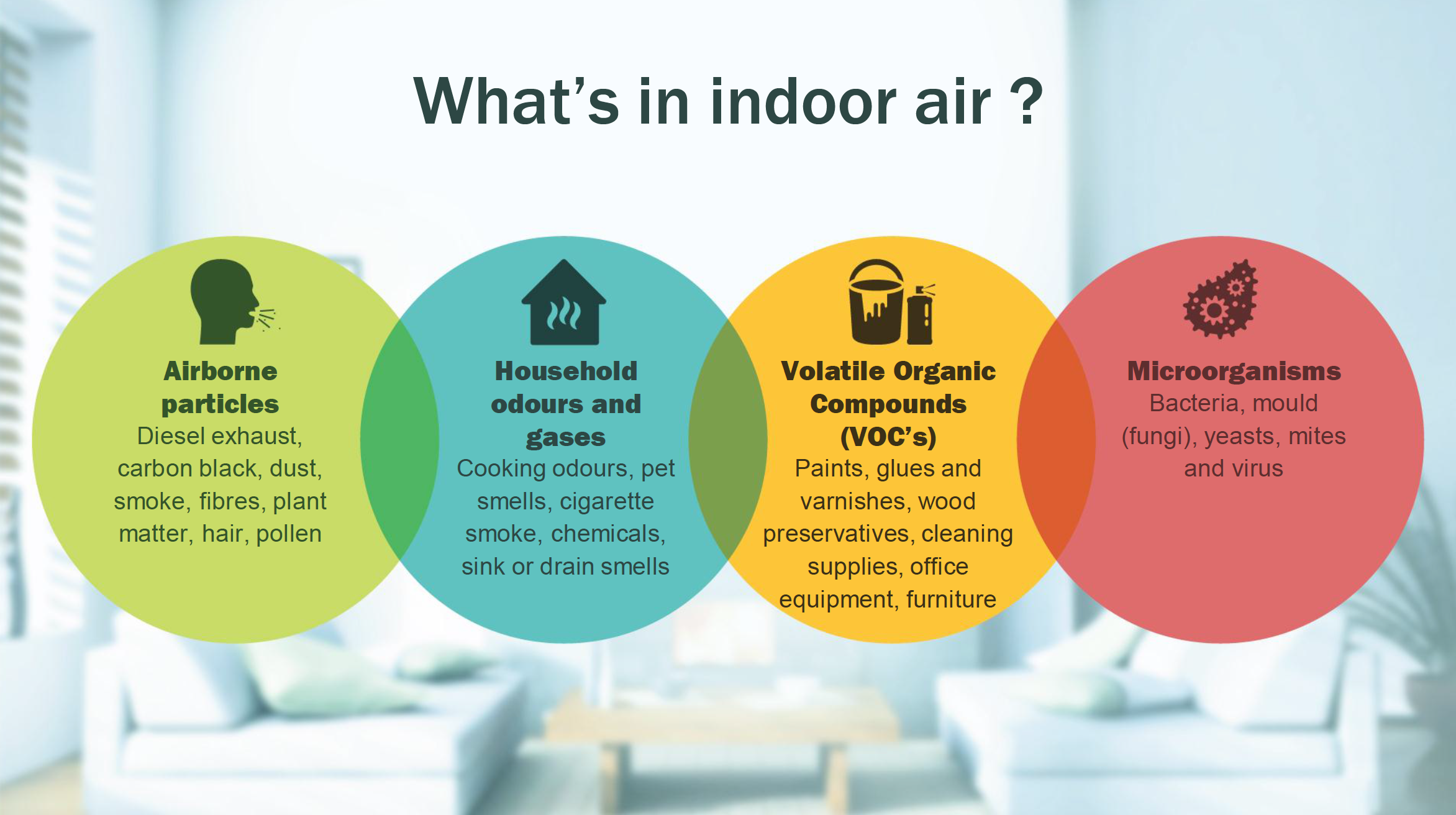Indoor air quality is a critical aspect of our daily lives, affecting not just our comfort but also our health and productivity. In spaces where we spend approximately 90% of our time—homes, offices, and schools—the impact of air quality on health can be profound. Poor indoor air can lead to various health issues, from mild allergies to severe respiratory problems, making it essential to understand how we can improve indoor air quality. Healthy buildings are those that prioritize clean and safe air, fostering environments conducive to well-being and efficient performance. As we delve into the relationship between air quality and productivity, we’ll uncover strategies that can significantly enhance the air we breathe indoors.
The term ‘indoor air quality’ encompasses various elements that contribute to the overall atmosphere within enclosed spaces, which significantly influence our health and wellness. This concept ties closely with the environments we inhabit daily, such as our workplaces and residential areas, impacting not only our physical health but also our cognitive functions and emotional well-being. More specifically, the health effects linked to indoor air dynamics—ranging from allergens to volatile organic compounds—highlight the necessity for awareness and proactive measures in ensuring clean air. In the quest to foster healthy spaces, optimizing air conditions emerges as a key factor in enhancing employee productivity and overall quality of life. By examining the factors that affect air purity and exploring methods to improve indoor environments, we can better understand the importance of creating spaces that support not just survival, but thriving.
Understanding Indoor Air Quality and Its Importance
Indoor air quality (IAQ) refers to the condition of the air within buildings and structures. It is crucial because we spend approximately 90% of our time indoors—from homes to offices and schools. The air we breathe heavily influences our health and well-being. Poor air quality can lead to a range of health problems, including allergies, respiratory diseases, and a decline in overall cognitive function. Research has shown that regulating indoor air pollutants can significantly improve health outcomes, proving that IAQ directly correlates with the quality of our lives.
Maintaining good indoor air quality is essential not just for physical health but also for mental well-being. For instance, studies conducted by Harvard researchers have established a direct link between improved ventilation in workplaces and enhanced cognitive function among employees. These findings highlight the importance of assessing and optimizing IAQ to create healthier building environments that can lead to increased productivity and overall satisfaction in day-to-day activities.
The Impact of Air Quality on Health
The impact of air quality on health cannot be overstated. According to experts, poor indoor air quality can expose individuals to a slew of harmful pollutants that originate from various sources, including chemicals from cleaning products, allergens like dust and mold, and even stale air. Over time, such exposure can lead to chronic health conditions, disrupt cognitive functions, and impair productivity. Many different environmental factors contribute to these issues, including inadequate ventilation and the presence of toxic substances.
Moreover, the significance of maintaining a clean and healthy indoor environment has been recognized in numerous health guidelines. For example, strategies to mitigate indoor air pollution include increasing outdoor air intake and employing high-efficiency filtration systems. This proactive approach not only enhances individual health but also fosters a healthier lifestyle within communities, thereby minimizing the risk of widespread health issues linked to air quality.
Improving Indoor Air Quality: Effective Strategies
Improving indoor air quality is paramount for fostering a healthier living and working environment. Simple yet effective steps can be taken to enhance IAQ, such as using high-efficiency particulate air (HEPA) filters, regularly maintaining HVAC systems, and incorporating more plants into indoor spaces. Additionally, increasing ventilation can alleviate the concentration of indoor pollutants, making the air fresher and safer to breathe. It is essential for building managers and homeowners alike to be aware of the strategies that can lead to cleaner air.
Implementing these strategies does not simply create more pleasant indoor spaces; it has profound implications for occupant health and performance. Research indicates that improved air quality results in lower absenteeism rates and higher productivity levels in workplace settings. Therefore, investing in better indoor air practices is not only beneficial for well-being but also a sound economic decision. Healthy buildings promote not only the health of individuals but also the economic health of organizations.
Healthy Buildings: The Future of Indoor Environments
The concept of healthy buildings has gained traction over the past few years, driven by a growing awareness of how indoor environments affect our health. Healthy buildings incorporate design and operational strategies that ensure optimal indoor air quality, natural light, and access to green spaces. These elements collectively contribute to the physical and mental well-being of occupants, enhancing their overall quality of life.
Adopting healthy building practices emphasizes the importance of sustainable construction and continuous improvement of indoor environments. For example, using non-toxic materials, ensuring proper ventilation, and fostering awareness about maintaining clean indoor air can collectively make a significant difference. As more architects and builders commit to creating healthy spaces, the public will benefit from environments that support their health, productivity, and happiness.
Air Quality and Productivity: A Recognized Link
Research has consistently shown that air quality and productivity are intrinsically linked. In work environments with improved air quality, employees not only report higher job satisfaction but also demonstrate better focus and efficiency. A Harvard study revealed that employees working in well-ventilated spaces with fresh air performed tasks much better than those in poorly ventilated conditions. This evidence suggests that companies should prioritize measures that improve indoor air quality to enhance occupational outcomes.
Additionally, excessive indoor pollutants can lead to what is popularly known as ‘sick building syndrome,’ whereby employees report acute health issues directly linked to the air quality of their surroundings. It precipitates a direct impact on a company’s bottom line through decreased productivity and increased illness-related absences. Understanding the tangible benefits of investing in air quality improvements equips employers with the knowledge necessary to create motivating and healthy workspaces.
Taking Action: Ways to Reduce Indoor Air Pollutants
To mitigate indoor air pollutants effectively, individuals and organizations can take several proactive actions. Regular cleaning routines help reduce dust, allergens, and other harmful contaminants present in indoor air. Utilizing air purifiers equipped with HEPA filters can also capture small particles, improving the air quality significantly. Moreover, taking steps such as banning smoking indoors and reducing the use of harsh chemicals will further enhance the indoor environment.
Another effective way to improve indoor air quality is through proper ventilation. Ensuring that your space is ventilated adequately allows fresh outdoor air to circulate and dissipate indoor pollution. Opening windows when weather permits and using exhaust fans in kitchens and bathrooms can make a substantial difference in maintaining good air quality. By incorporating these actions, spaces can become healthier and more conducive to overall well-being.
The Role of Ventilation in Maintaining Healthy Indoor Air
Ventilation plays a crucial role in maintaining healthy indoor air quality, making it one of the most effective interventions available. Adequate ventilation helps to dilute and remove indoor pollutants, which can originate from cooking, cleaning products, pets, and even furniture. By allowing fresh air to enter and circulate within buildings, it can significantly reduce the concentration of varied contaminants, thereby promoting a healthier environment.
Implementing effective ventilation systems, such as mechanical and natural ventilation, is key to ensuring a constant supply of fresh air. Enhanced ventilation not only protects occupants from high levels of indoor pollution but also minimizes chances of allergens and microbes that can lead to health issues. Understanding and investing in proper ventilation systems is crucial for both residential and commercial spaces in achieving optimal indoor air quality.
Monitoring Indoor Air Quality: The First Step to Awareness
Monitoring indoor air quality is essential for identifying potential hazards within a building. By regularly assessing the levels of pollutants, humidity, and ventilation, building managers can pinpoint problem areas and implement necessary changes to improve air quality. Various tools and technologies are available today that provide real-time insights or periodic assessments of indoor air conditions.
Awareness of indoor air quality allows both occupants and management to be proactive in maintaining a healthy atmosphere. With the data collected from monitoring, strategies can be developed to address specific issues such as increasing ventilation, reducing specific pollutant sources, or complying with environmental health standards. Emphasizing indoor air quality as an essential aspect promotes healthier living and working conditions for everyone involved.
The Future of Indoor Air Quality Research and Innovations
As the importance of indoor air quality expands, research and innovations in this field are essential for future development. Ongoing studies aim to uncover new ways to assess and improve indoor air conditions effectively. From advances in air purification technologies to smart building designs that prioritize ventilation, innovation continues to play a significant role in elevating indoor air quality to new heights.
Colleges, universities, and research institutions are increasingly dedicating resources towards understanding the complex relationship between indoor air and health. As evidenced by research conducted at Harvard, insights gained from these investigations yield practical applications that can reshape how buildings are constructed and maintained. This forward-thinking approach is crucial in establishing standards that ensure safe, healthy, and productive indoor environments for generations to come.
Frequently Asked Questions
How does indoor air quality impact health?
Indoor air quality significantly impacts health as it can contribute to respiratory issues, allergies, and overall well-being. Poor air quality can exacerbate existing health conditions and lead to symptoms like fatigue and concentration difficulties.
What are some ways to improve indoor air quality in homes and offices?
Improving indoor air quality can be achieved through better ventilation, using air purifiers with HEPA filters, maintaining indoor humidity levels, and reducing the presence of indoor pollutants such as dust, smoke, and chemicals.
What is the relationship between air quality and productivity in the workplace?
Research shows that improved indoor air quality positively affects productivity. Enhanced ventilation and reduced pollutants lead to better cognitive function and a lower incidence of sick leave, thereby boosting overall employee performance.
How do healthy buildings promote better indoor air quality?
Healthy buildings promote better indoor air quality through design features like improved ventilation systems, the use of non-toxic materials, and regular maintenance practices that mitigate pollution sources and enhance occupant health.
What health issues are linked to poor indoor air quality?
Poor indoor air quality is linked to a variety of health issues including respiratory diseases, allergies, headaches, and fatigue. Long-term exposure can lead to chronic health problems and reduced quality of life.
Why is ventilation crucial for maintaining indoor air quality?
Ventilation is crucial for maintaining indoor air quality as it helps dilute and remove indoor pollutants, bringing in fresh outdoor air that reduces concentrations of harmful substances and enhances overall occupant health.
Can outdoor air pollution enter indoor spaces and affect indoor air quality?
Yes, outdoor air pollution can enter indoor spaces and significantly affect indoor air quality. Pollutants like particulate matter can be carried inside through open windows, doors, and through building ventilation systems.
What steps can be taken to monitor indoor air quality effectively?
Monitoring indoor air quality can involve using air quality sensors that track levels of common pollutants, humidity, and temperature. Regular testing and monitoring help identify issues and guide improvements.
How does indoor air quality influence mental health?
Indoor air quality can influence mental health by affecting mood, stress levels, and cognitive function. Poor air quality has been associated with increased anxiety and depression symptoms among occupants.
What role does indoor air quality play in public health?
Indoor air quality plays a significant role in public health as it influences the well-being of large populations who spend the majority of their time indoors. Ensuring healthy indoor environments is vital for preventing disease and promoting wellness.
| Key Point | Details |
|---|---|
| Indoor Time | Americans spend an average of 90% of their lives indoors. |
| Cognitive Function | A 2015 Harvard study showed that enhanced air ventilation improved workers’ cognitive function. |
| Building Ventilation | In the 1970s, ventilation rates in buildings changed mainly to limit complaints related to odors and improve health. |
| Indoor vs Outdoor Pollutants | Indoor spaces can have more harmful pollutants than outdoors. |
| Air Sharing | If living in an apartment, up to 30% of indoor air can come from neighboring units. |
| Improving Indoor Health | Opportunities exist to significantly improve indoor air quality. |
| Air Quality Impact | 1-3% of the air breathed indoors can come directly from others in the room. |
| Reducing Disease Spread | Bringing in outdoor air, increasing filtration, and using HEPA filters can reduce infectious diseases. |
| Dust Composition | Dust can be hormonally active, affecting health. |
| Chemical Regulations | Since 1976, only 200 of over 80,000 chemicals have been banned by the EPA. |
Summary
Indoor air quality is crucial to our overall health and well-being. It is essential to recognize the impact that the environments we occupy have on our cognitive function, health, and productivity. By understanding how indoor air quality can influence our daily lives, we can take proactive measures to improve our indoor environments, thereby enhancing our health and quality of life.



